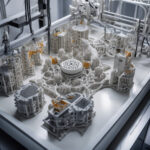‘Microflower’ structure amplifies magnetic fields 5x, can boost devices’ efficiency
Scientists have developed a tiny flower-shaped structure that’s made of a nickel-iron alloy to concentrate and amplify magnetic fields by up to five times. This innovative creation could potentially revolutionize various industries by significantly enhancing the efficiency of electronic devices that rely on magnetic fields.
The intricate design of the microflower structure plays a crucial role in its ability to amplify magnetic fields. Each petal of the tiny flower is carefully crafted to maximize the concentration of magnetic flux, allowing for a much stronger magnetic field compared to conventional materials. This unique configuration opens up a wide range of possibilities for improving the performance of magnetic-based technologies.
One of the key advantages of this breakthrough is its potential impact on the energy sector. Magnetic fields are widely used in generators and motors to convert mechanical energy into electrical energy. By incorporating the microflower structure into these devices, it is possible to boost their efficiency and overall performance. This could lead to significant energy savings and reduced environmental impact, making it a game-changer for sustainable energy production.
Moreover, the application of the microflower structure is not limited to the energy sector. Industries such as healthcare, telecommunications, and computing can also benefit from this innovative technology. For instance, magnetic resonance imaging (MRI) machines could see improvements in image quality and scanning speed, leading to better healthcare outcomes for patients. In the field of telecommunications, devices like antennas and magnetic sensors could become more sensitive and accurate, enabling faster and more reliable communication networks.
The potential of the microflower structure extends to the consumer electronics market as well. Smartphones, tablets, and other portable devices that rely on magnetic components for functions like compasses and speakers could experience a significant performance boost. This could result in longer battery life, faster processing speeds, and overall better user experience for consumers.
In addition to its technical advantages, the microflower structure also presents opportunities for cost savings in manufacturing. Due to its small size and efficient design, less material is required to create the structure, making it a cost-effective solution for mass production. This could lead to the widespread adoption of this technology across various industries, further accelerating innovation and driving economic growth.
As scientists continue to explore the full potential of the microflower structure, the future looks promising for magnetic field applications. By harnessing the power of this tiny yet powerful innovation, we can expect to see significant advancements in efficiency, performance, and sustainability across a wide range of industries.
In conclusion, the development of the microflower structure marks a significant milestone in the field of magnetic field amplification. With its ability to boost magnetic fields by up to five times, this innovative technology has the potential to revolutionize various industries and pave the way for a more efficient and sustainable future.
efficiency, magnetic fields, technology, innovation, sustainability












